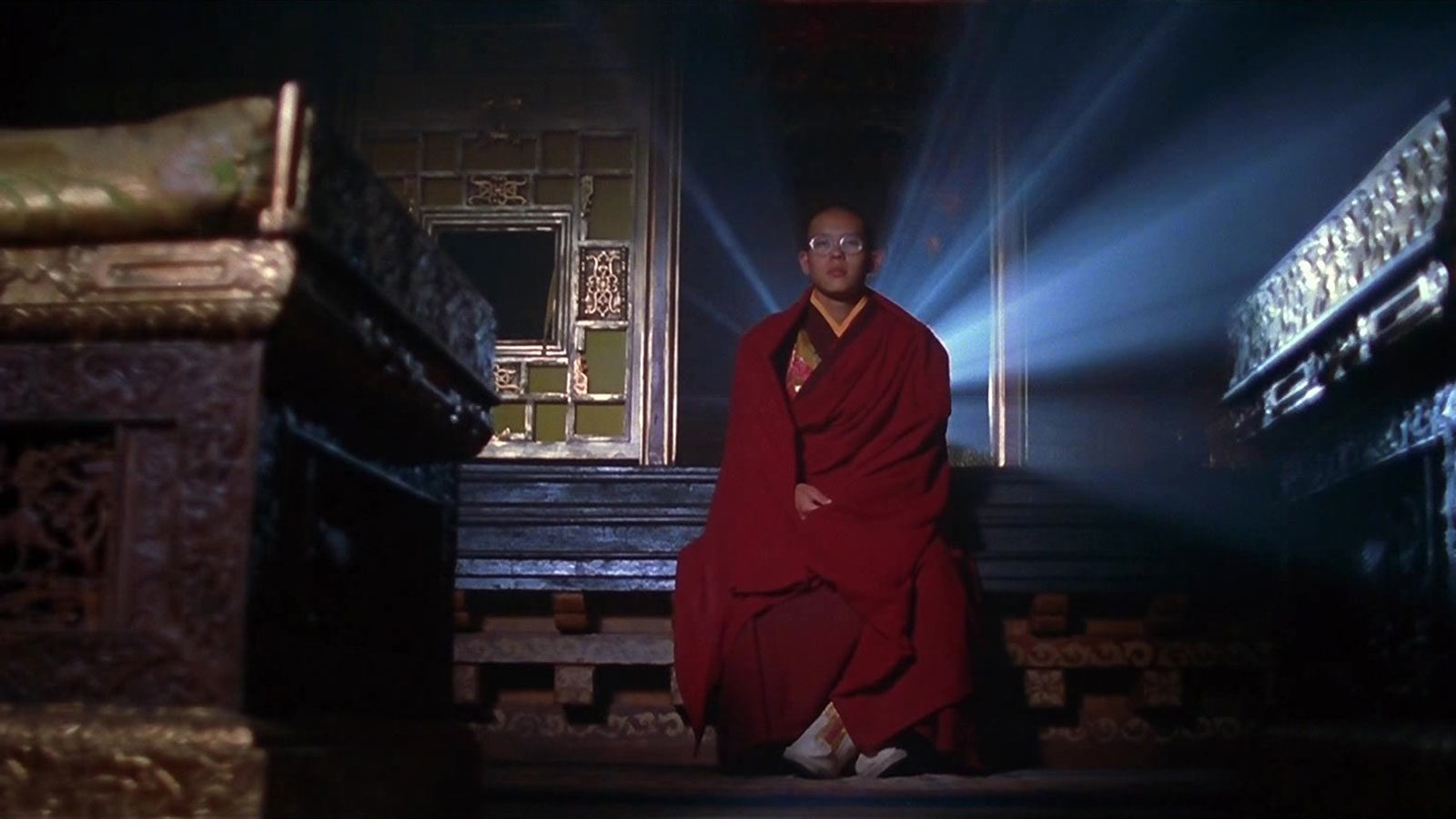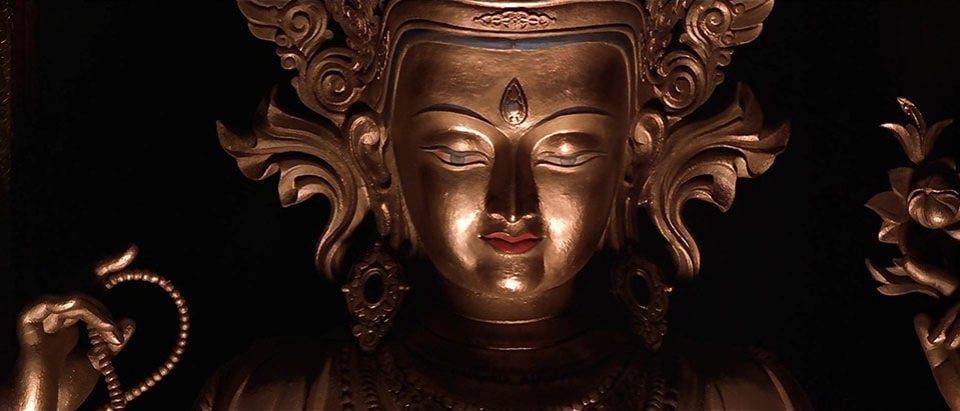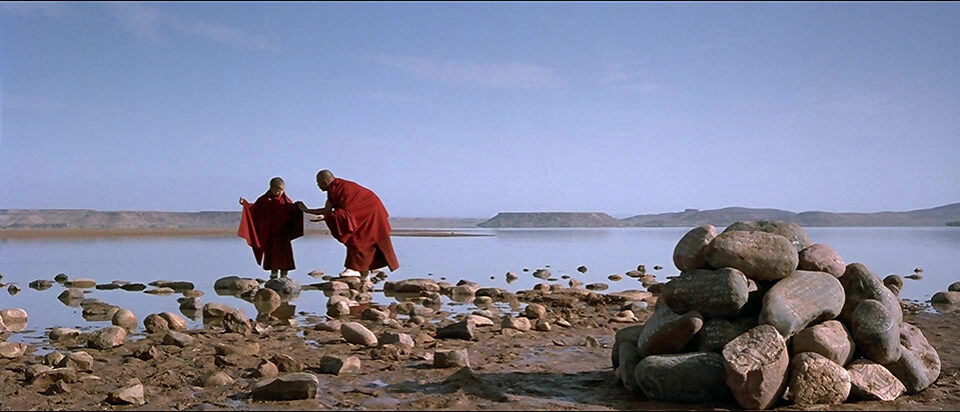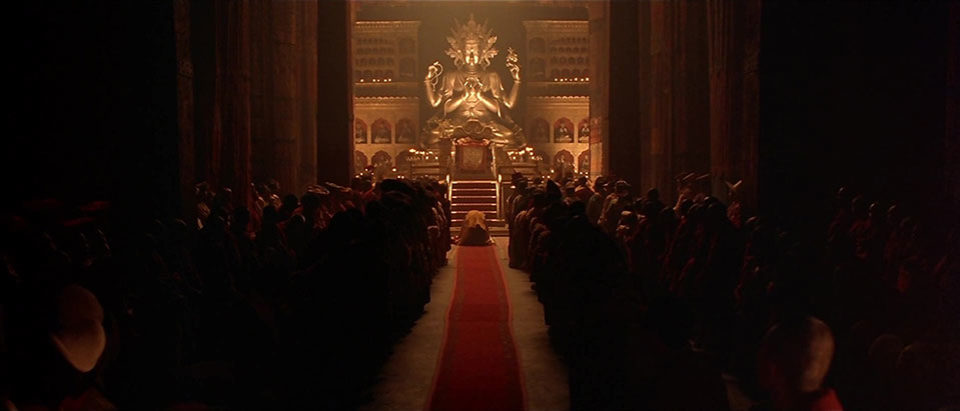
The elusive search for peace, for equilibrium, has always been latent in the films of Martin Scorsese. But still, what does it mean for American cinema's de facto poet laureate of the street to make an "historical epic" about the spiritual coming of age and flight into exile of the young Dalai Lama after the invasion of feudal Tibet by communist China? Kundun, which takes its name from the Dalai Lama's formal title, surely originates in an impulse to get closer to the transcendental source, which in turn demands the embracing of an Otherness seemingly antithetical to the milieux and manners of urban America. In those terms Kundun is a worthy soulmate to Jean Renoir's The River, which also begins with a painted image from a tradition that offers a gateway to ancient religious wisdom. But while Scorsese's film has the same spirit of humanist grace and the same profoundly moving cumulative power as Renoir's, its extraordinary visualization and mesmerizing textures and patterns carry it into another realm of formal wonder—a uniquely metaphysical spectacle.
In some ways Kundun seems a companion piece to The Last Temptation of Christ: both films begin with the image of a sleeper awakening, both are about the emergence of dormant divinity in human guise, the protagonists of both films embark on transformative voyages of discovery. But where the Christ of Last Temptation trades in his low self-esteem for an exultant sense of revolutionary mission, the Buddha-child Dalai Lama of Kundun follows a reverse trajectory: from egocentric infant to selfless religious statesman.
Scorsese’s films are almost always constructed around narcissistic protagonists who typically deny or defy reality in order to inhabit increasingly lonely, paranoid fantasies of supremacy and control, sustained by forces of both repression and anarchic violence. Either cut off from redeeming connection to community or oppressed by it, their self-defeat, breakdown, and entropy seem preordained. The disruptive, anguished Christ of Last Temptation descends remotely from this tradition. By contrast, Kundun‘s Dalai Lama is not so much outside this pattern as its benign negative or mirror image. In his splendid isolation, he’s the very foundation of the world of the film, but his selfhood is the calm at the eye of the hurricane, propelled by curiosity and the getting of wisdom rather than some compulsive need for gratification and oblivion. What previous Scorsese protagonist has even had the option to follow the path to spiritual enlightenment? And enlightenment for Scorsese is envisioned, among other things, as Cinema itself: The Dalai Lama’s visionary dream states, which manifest themselves with beguiling seamlessness within the action, and his eerie consultations with a hissing Oracle, are supplemented by recourse to a telescope (a surrogate movie camera), and a flickering movie projector that yields glimpses of the Pathé silent The Hen That Laid the Golden Egg, a newsreel of the destruction of Hiroshima, and the geopolitically apposite Henry V. Through these and other devices, Kundun systematically works through a series of plays on vision —both spiritual and sensory —and viewpoint, that in some ways represent a culmination of Scorsese’s formal inquiries. If all his films are ultimately, inescapably interiorized, their momentum always spiraling relentlessly inward, Kundun is the first that exists in the mind’s eye from the beginning, that locates the art of vision in a realm where exterior landscape (Tibet, history) and interior landscape (a sand-painting mandala, an infinite capacity for compassion) unite in an epic of the psyche and the spirit.
Sure, it’s only a movie. And Kundun isn’t naïve about its own position in the marketplace. Scorsese is careful to pull the curtain back to sneak a peek at what goes on behind closed doors when powerful men gather to take care of business. And it’s certainly business as usual in China, where Mickey Mouse and McDonald’s are finishing what Kissinger and Nixon started: after all, the visionary chairman of Disney recently pronounced with characteristic soulessness, “The Chinese don’t understand that films are often gone in three weeks.” The ephemeral and the enduring—nothing could be more germane to the concerns of Kundun. You decide: who’ll be lucky to be even a footnote in movie history, Eisner or Scorsese?—G.S.

How did this project come to you?
Jay Maloney, at the time my agent at CAA, sent me Melissa Mathison’s script. Usually I have my own projects lined up. I like to do the films I want to do, but then again, the way this business has been going, I have to slip in a Cape Fear or even a Casino to a certain extent—because that wasn’t on my agenda, it was on Hollywood’s agenda for me. So to bring in a script from outside is almost unheard of. I had known about Melissa though E.T. and another project I was involved with very briefly in the late Eighties, something that we talked about but which she didn’t have time to write—Winter’s Tale, from a Mark Helprin book. And she reminded me that I knew her twenty years ago in Los Angeles in the mid-Seventies.
I read the script and liked its simplicity, the childlike nature of it, that it wasn’t a treatise on Buddhism or a historical epic in the usual sense. It’s just too much to know about Tibet and China and their relationship over the past fifteen hundred years. That was all incidental. What you really dealt with was the child and the child becoming a young boy and the boy becoming a young man —his spiritual upbringing, and this incredible responsibility which he inherits and how he deals with it on the basis of nonviolence. And the concept of him escaping and taking Tibetan culture and religion with him to the rest of the world.
The journey that Kundun takes the viewer on is unlike anything you’ve undertaken previously, and it brings you ultimately to a more emotional place than any of your other films except perhaps The Age of Innocence.
It is about where you arrive. I must say that we had to go from the end back to the beginning, and it was quite a journey for us, too. First of all, Melissa Mathison’s writing: we went through fourteen drafts, and we knew we were on the right track when our last draft resembled the first and second drafts more.
We had a leisurely time rewriting the script, and different concepts came up during our working together. I tried to get more historical detail in; for instance, the 13th Dalai Lama was the first to be photographed, so we began with him, showed the photography session. I was getting into the cultural aspects of it. Finally I realized that scaling down everything and keeping it personal would cut away a lot of the unnecessary political intrigues and, much as I admire them, typical elements of historical epics. And so it made it something very simple.
Something similar happened in the editing. I delineated the sections by the different ages of the Dalai Lama. The first section with the 2-year-old was pretty much straight narrative. In the section with the 5-year-old, who goes to the Potala for the first time and meets the Lord Chamberlain, scenes began to be shuffled around. And the 12-year-old section, same thing. And then in the section with the 18-year-old Dalai Lama, scenes were shuffled more. So we wound up cutting the picture purely on an emotional level, almost like a documentary, so that we shuffled around scenes that were shot for other sections of the picture and also in different locations. And what worked more for us were the dreamlike states rather than narrative scenes.
Working on these drafts, was there a point when you felt sure this was a film you could make?
I think the only real concrete thing was when I realized that I should probably try to do everything from the child’s point of view. Not just low-angled shots or camera movement that’s low-angle, but that as the child is growing, everything around him is seen by him, so the audience shouldn’t be privy to a lot of information that the boy is not privy to. And when the Dalai Lama is privy to it, it’s incomprehensible to him. Like in a family, if the adults are talking and there’s a problem, a child can tell. And there’s the fear and uncertainty, the parental figures coming and going—for example, Reting.
I wasn’t interested in the romantic, emotional view of Tibet, crystallized over the years in Lost Horizon. On “Frontline” last week there was a snide reference to emptyheaded, well-meaning people in Hollywood making films about Tibet, and I really didn’t like that. I needed to show that it wasn’t Shangri-La, that there were political problems, that monks had guns, there were dungeons and an army. How do you show that without explaining all that was going on between Reting and Taktra, the older teacher? The only way I could do it was to do it through the child’s eyes—at least to infer, by the child witnessing these things, and asking, “Where’s Reting?” “Well, he’s away.” “How long’s he going to be gone?” “Oh, about three or four years.” And then he asks later, “Why do monks have guns?” “Yes, in this case they have guns.” In this case they have guns. I liked very much playing on the Kashag wideshot, where they’re a little uncomfortable in answering all these questions. There are all kinds of hints in the picture, all the way through. His father was very friendly with Reting.

Yes, you get these glimpses of the father and you’re wondering, Well what’s going on here?
[Laughs.] He’s having a great time. He prospered well, but he died suddenly. Reting is said to have been very close with the Chinese; that’s maybe one of the reasons for finding the boy in Amdo Province, which is practically a Chinese province. They had to make a deal with a Chinese warlord, it cost them a lot of money and took three years to get the kid out of Amdo. There’s a lot going on there and we just wanted to imply it, so that those who know the story can say, Fine, it’s accurate, and those who don’t know could ask questions, and if they’re interested, there’s a lot of books on it.
Did you meet the Dalai Lama?
I first met with him through Melissa, a brief meeting in Washington, and last year we wound up going to India for final meetings. The week that Age of Innocence opened, I went to visit Melissa and Harrison Ford at their house in Wyoming with Barbara De Fina and some other associates of mine. The Dalai Lama was also there with his retinue and we talked for two days. Melissa really had the relationship with him, and what she did was question him about certain specifics, and if something was dreadfully wrong he would say, “Oh it wasn’t that way.” Or he would say, “I don’t really agree with that so much, but it’s totally up to you—that’s your prerogative to use if you want.” But there were some key political things, like the use of the state seal, which had to be made very clear.
Had he seen any of your films?
No. That’s why Melissa and everybody were giggling: they wondered which one of my films they should show him. I don’t think they came up with anything. But some of the people around him had seen Last Temptation.
To what degree was going into this completely unfamiliar milieu a source of difficulty?
It was freeing in a way. Once we got to shoot and had those nonactors in the scenes, something about their faces and presence took over. Often the emotional impact goes through them.
By structuring the film around one character’s point of view, was there a sense of putting on a formal straitjacket, and was that part of the challenge?
Yes, I think so. To do that, and also imply the culture and imply the spirituality. And enough shots that imply it are layered one to the other, one over the other, that ultimately I was gambling on the emotional impact.

It’s a strange process, making a film and it all being a gamble, having no guarantee that it will culminate in the emotion you’re looking for.
Can’t guarantee. No. Thelma [Schoonmaker Powell, Scorsese’s editor] was a big help in pulling together certain scenes, giving me ideas and playing around with certain things. We knew that we were out on a limb. It was a process filled with anxiety, to say the least.
When you live with a film every day for two years, do you go through many stages in terms of your emotional connection to it?
[Laughs.] Yeah. With King of Comedy, I wasn’t in very good physical shape at the time and I had very great difficulty shooting every day. I’ve always felt badly over the years that I tried Jerry Lewis’s and Robert De Niro’s patience a lot by not being physically well enough to pull myself together in the mornings to really know what I was shooting. [Laughs.]. It was just a bad period in my life….
When you come to editing, is there a danger of becoming deadened or desensitized?
No, I don’t become dead to it. I get jaded to certain sequences and certain cuts, but if you become dead to it, then the picture’s just not working, which means I’m not working. That means I can’t make a movie. I get angry, frustrated, excited, very happy, then totally depressed, and anxiety-ridden constantly. It’s a situation where you can’t sleep well and the process is on your mind constantly. I had a similar thing happen in Casino. The writing with Nicholas Pileggi was fraught with anxiety and difficulties, because I tried to create a sort of an epic out of America and Hollywood in a way. And it’s not tried and true; even though we were still dealing with narrative, we were trying to venture out into a different kind of storytelling, so you don’t know where the pitfalls are going to be. Yeah, you take a gamble and say, It’s going to be wall-to-wall narration, and the narration’s going to be layered this way and that—okay. In Kundun, no narration. Simple shots. Not simple in execution, but simply done, where the lighting takes over.
Can you imagine making a film at this point where there is no gamble?
No, I’m afraid not….
Read all of Gavin Smith’s interview with Martin Scorsese in the January-February 1998 issue.